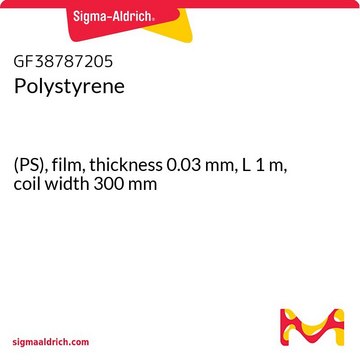331651
Polystyrene
average Mw 35,000
Synonyme(s) :
PS
Se connecterpour consulter vos tarifs contractuels et ceux de votre entreprise/organisme
About This Item
Formule linéaire :
[CH2CH(C6H5)]n
Numéro CAS:
Numéro MDL:
Code UNSPSC :
12162002
ID de substance PubChem :
Nomenclature NACRES :
NA.23
Produits recommandés
Forme
beads or pellets
Niveau de qualité
Poids mol.
average Mw 35,000
Température de transition
softening point (ASTM E 28) 123-128 °C
Densité
1.06 g/mL at 25 °C
InChI
1S/C8H8/c1-2-8-6-4-3-5-7-8/h2-7H,1H2
Clé InChI
PPBRXRYQALVLMV-UHFFFAOYSA-N
Vous recherchez des produits similaires ? Visite Guide de comparaison des produits
Description générale
Polystyrene is a high molecular weight synthetic polymer made from the polymerization of styrene. It is durable, thermoplastic, and hydrophobic in nature.
Application
Polystyrene(PS) can be used as a precursor to synthesize dye-doped fluorescent PS nanoparticles, which can be applied in the field of optical microscopy, cell tracking, and optical sensors.
It can be used to stabilize the perovskite component by forming PS-capped perovskite grains. This PS coverage can suppress the organic component evaporation, and water corrosion and promotes crystal self-healing of perovskite films.
Due to its optical clarity, low production cost, and ease ofmanufacture, it is widely used as a fundamental substrate for in vitrocell culture.
It can be used to stabilize the perovskite component by forming PS-capped perovskite grains. This PS coverage can suppress the organic component evaporation, and water corrosion and promotes crystal self-healing of perovskite films.
Due to its optical clarity, low production cost, and ease ofmanufacture, it is widely used as a fundamental substrate for in vitrocell culture.
Caractéristiques et avantages
- Thermal efficiency
- Durability
- Moisture resistance
Forme physique
Bimodal.
Code de la classe de stockage
11 - Combustible Solids
Classe de danger pour l'eau (WGK)
WGK 3
Point d'éclair (°F)
Not applicable
Point d'éclair (°C)
Not applicable
Équipement de protection individuelle
Eyeshields, Gloves, type N95 (US)
Faites votre choix parmi les versions les plus récentes :
Déjà en possession de ce produit ?
Retrouvez la documentation relative aux produits que vous avez récemment achetés dans la Bibliothèque de documents.
Les clients ont également consulté
Hiroyuki Yanagisawa et al.
Molecules (Basel, Switzerland), 23(4) (2018-03-23)
This study was conducted with the aim of achieving the simultaneous screening of various additives in polymer materials by utilizing a solvent-free pyrolyzer/thermal desorption gas chromatography mass spectrometry (Py/TD-GC-MS) method. As a first step to achieve this goal, simultaneous screening
Prasert Akkaramongkolporn et al.
AAPS PharmSciTech, 10(2), 641-648 (2009-05-20)
The differently sulfonated styrene-divinylbenzene cross-linked copolymer cationic exchange resins were prepared by oil-in-water polymerization and varied degrees of sulfonation. Several characteristics of the obtained resins were evaluated, i.e., Fourier transform infrared spectra, the ion-exchange capacity, microscopic morphology, size, and swelling.
Hui Xia et al.
Journal of colloid and interface science, 376(1), 322-326 (2012-03-27)
The aggregation kinetics of particles in dense polystyrene latex suspensions is studied by low-coherence fiber optic dynamic light scattering. Low-coherence fiber optic dynamic light scattering is used to measure the hydrodynamic radius of the aggregates. The aggregation kinetics data obtained
Harikrishnan Narayanan Unni et al.
Electrophoresis, 30(5), 732-741 (2009-03-05)
This study reports a theoretical and experimental study on the irreversible deposition of colloidal particles from electrokinetic microfluidic flow. The electrokinetic particle transport model presented in this study is based on the stochastic Langevin equation, incorporating the electrical, hydrodynamic, Derjaguin-Landau-Verwey-Overbeek
Iván A Hinojosa et al.
Marine pollution bulletin, 58(3), 341-350 (2009-01-07)
Floating marine debris (FMD) is reported from all oceans. The bulk of FMD are plastics, which due to their longevity cause multiple negative impacts on wildlife and environment. Identifying the origins of FMD (land- or sea-based) is important to take
Notre équipe de scientifiques dispose d'une expérience dans tous les secteurs de la recherche, notamment en sciences de la vie, science des matériaux, synthèse chimique, chromatographie, analyse et dans de nombreux autres domaines..
Contacter notre Service technique


